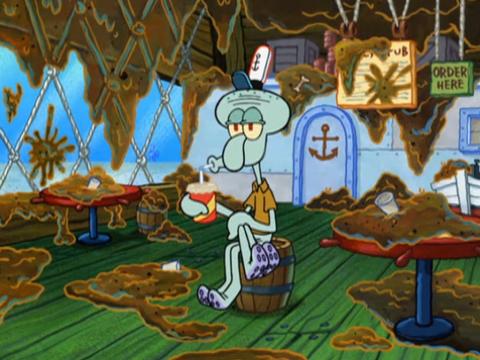Squid on Strike: How children’s TV introduced us to industrial action
A child growing up in the US can be exposed to a number of things: low-standard fast food chains, nation-wide gun violence and Spongebob Squarepants, all with varying effects. But in the case of Spongebob, despite the central premise being about the titular character living under the sea and having various adventures, there were many lessons about the service industry to be found beneath the nautical nonsense. It was the first show many kids watched that reflected chain restaurant management with the episode ‘Selling Out’. It introduced kids to gender-based workplace harassment in ‘That’s No Lady’ and it was confident enough to make an entire episode a workplace training manual in ‘The Krusty Krab Training Video’. So unsurprisingly, the show didn’t shy away from the more serious sides of working in the service industry and, with the episode ‘Squid on Strike’, it introduced kids to industrial action.
All of this is important to teach as it means when said kids grow up, they at least have a subconscious understanding that they have rights and can fight for them
‘Squid on Strike’, released in 2001, is a sound example of making the act of going on strike funny without belittling the characters for demanding their rights as employees or dumbing down the subject for younger audiences. It begins by having the often-greedy Mr Krabs charge his employees for “breathing” and “existing,” a practice only Ryanair would likely consider in real life. Squidward, the cephalopodic embodiment of contempt, decides to quit and takes Spongebob with him to go on strike. As one would expect, hilarious antics ensue. Spongebob plays the audience surrogate while Squidward teaches him the art of making picket signs (which, when mistranslated, gets him trampled) and exclaims borderline Marxist rhetoric (which, when the people get bored, gets him trampled and more than likely led conservatives to believe the show was promoting communism). Eventually, the strike is sorted with Krabs negotiating with Squidward off-screen, while Spongebob goes off the deep end and takes his fellow striker’s advice to “dismantle the establishment” entirely too literally.
Throughout all of this, ‘Squid on Strike’ does a lot right – it never patronises kids and simultaneously isn’t preachy. Instead, it shows workers protesting for their rights being ridiculed for it and, in the end, shows the right way (peaceful negotiation) and the wrong way (destroying the workplace) to handle the situation. All of this is important to teach as it means that when said kids grow up, they at least have a subconscious understanding that they have rights and can fight for them, as well as the approach to take if the situation changes entirely.
by addressing kids at varying ages, they’re better educated and are able to see multiple sides to what can be complex problems when they arise in real life
So, while this acts as a particularly good example of how industrial action is shown in a cartoon aimed squarely at children – does the same apply to a slightly higher age bracket? Enter the show that comments on literally everything – The Simpsons and the memorable episode ‘The PTA Strikes’. Here, due to terrible working conditions, the staff of Springfield Elementary go on strike, with consequences ranging from Lisa’s existential crisis to neighbourhood members becoming teachers (incurring every child’s worst nightmare – having their parents come in to teach). Like ‘Squid on Strike’, there are a number of great jokes (Bart’s anarchy and children taking advantage of their newly found freedom) but it also approaches the subject from a number of angles. Homer represents the complacent approach of hating one’s job and responding by doing it in a half-assed manner instead of doing anything. Principal Skinner reveals how such conditions are made in the first place – school budgets kept low with resistance to needed higher taxes and the teachers involved are put in a position where they have to negotiate and think up a new way of finding money. Again, it’s witty, but unpatronizing, clever and can be approached by kids (who have extra incentives to see strikes end after the move by the PTA in the episode’s second half) and it shows that striking action can be taken seriously in cartoons.
Children’s entertainment never has to shy away from seemingly grown-up issues and, by addressing kids at varying ages, they’re better educated and are able to see multiple sides to what can be complex problems when they arise in real life. As solutions are sought for the current teaching strikes in universities, it’s worth remembering that the students watching are more than likely to have at least heard of the above episodes, and because of that may be willing to push for quicker, fairer solutions to the problems that require industrial action to solve. And that’s always a good thing.

Comments